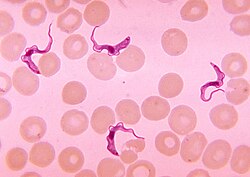Kinetoplastid
The kinetoplastids are a group of single-cell flagellate eukaryotes. They include a number of parasites responsible for serious diseases in humans and other animals. There are also forms found in soil and aquatic environments. They are members of the phylum Euglenozoa.
| Kinetoplastida | |
|---|---|

| |
| Trypanosoma cruzi parasites | |
| Scientific classification | |
| Unrecognized taxon (fix): | Kinetoplastea |
| Subdivisions | |
| Synonyms | |
| |
Their main distinguishing feature is the presence of a kinetoplast, a DNA-containing granule inside the single mitochondrion at the base of the cell's flagella (the basal body).
The kinetoplastids were first defined by Honigberg in 1961 as the flagellate order Kinetoplastida.[3] They are traditionally divided into the biflagellate Bodonidae and uniflagellate Trypanosomatidae.
The Trypanosomatidae includes several genera which are exclusively parasitic. Trypanosoma brucei causes Sleeping sickness; Trypanosoma cruzi causes Chagas disease, Leishmania causes leishmaniasis, Crithidia is parasitic on insects, and Cryptobia is an ectoparasite on the gills of fish.
Bodo is typical of the free-living Bodonids, and includes various species which feed on bacteria.
Kinetoplastid Media
Bodo sp.
References
- ↑ Honigberg, B. M. (1963). "A contribution to systematics of the non-pigmented flagellates.". In Ludvík, J.; Lom, J.; Vávra J. (eds.). Progress in Protozoology: proceedings of the first International Congress on protozoology held at Prague. Academic Press.
- ↑ Cavalier-Smith, T. (1981). Eukaryote kingdoms: seven or nine? Biosystems 14, 461–481.
- ↑ Honigberg B.M. "A contribution to systematics of the non-pigmented flagellates.". In Ludvík J; Lom J.; Vávra J. (eds.). Progress in Protozoology: proceedings of the first International Congress on protozoology held at Prague. Academic Press.

